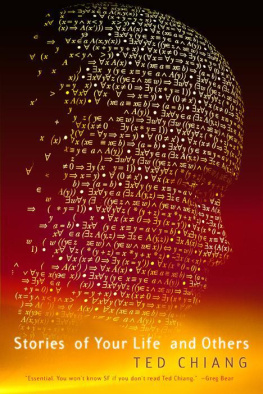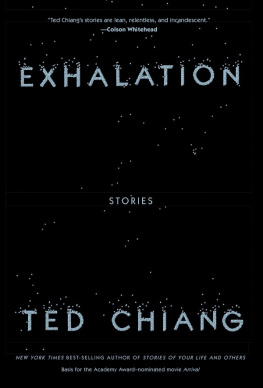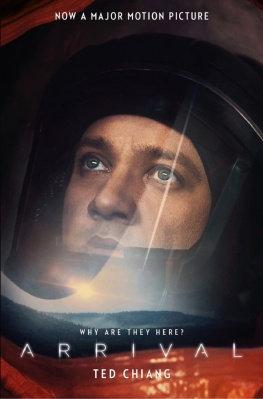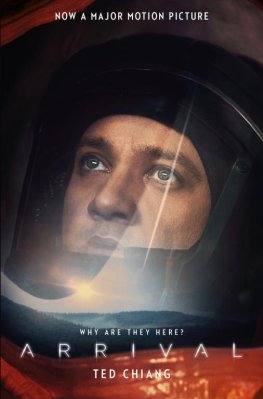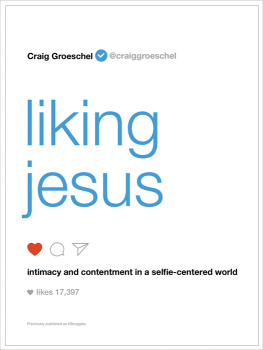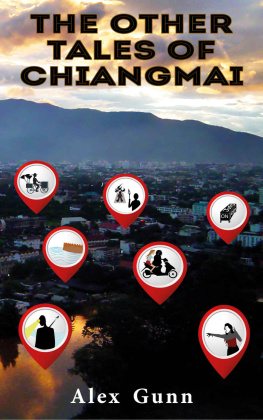Ted Chiang - Liking What You See: A Documentary
Here you can read online Ted Chiang - Liking What You See: A Documentary full text of the book (entire story) in english for free. Download pdf and epub, get meaning, cover and reviews about this ebook. genre: Science fiction. Description of the work, (preface) as well as reviews are available. Best literature library LitArk.com created for fans of good reading and offers a wide selection of genres:
Romance novel
Science fiction
Adventure
Detective
Science
History
Home and family
Prose
Art
Politics
Computer
Non-fiction
Religion
Business
Children
Humor
Choose a favorite category and find really read worthwhile books. Enjoy immersion in the world of imagination, feel the emotions of the characters or learn something new for yourself, make an fascinating discovery.

- Book:Liking What You See: A Documentary
- Author:
- Genre:
- Rating:5 / 5
- Favourites:Add to favourites
- Your mark:
- 100
- 1
- 2
- 3
- 4
- 5
Liking What You See: A Documentary: summary, description and annotation
We offer to read an annotation, description, summary or preface (depends on what the author of the book "Liking What You See: A Documentary" wrote himself). If you haven't found the necessary information about the book — write in the comments, we will try to find it.
Liking What You See: A Documentary — read online for free the complete book (whole text) full work
Below is the text of the book, divided by pages. System saving the place of the last page read, allows you to conveniently read the book "Liking What You See: A Documentary" online for free, without having to search again every time where you left off. Put a bookmark, and you can go to the page where you finished reading at any time.
Font size:
Interval:
Bookmark:
Liking What You See: A Documentary
by Ted Chiang
Beauty is the promise of happiness.-Stendhal
Tamera Lyons, first-year student at Pembleton:
I cant believe it. I visited the campus last year, and I didnt hear a word about this. Now I get here and it turns out people want to make calli a requirement. One of the things I was looking forward to about college was getting rid of this, you know, so I could be like everybody else. If Id known there was even a chance Id have to keep it, I probably wouldve picked another college. I feel like Ive been scammed.
I turn eighteen next week, and Im getting my calli turned off that day. If they vote to make it a requirement, I dont know what Ill do; maybe Ill transfer, I dont know. Right now I feel like going up to people and telling them, Vote no. Theres probably some campaign I can work for.
Maria deSouza, third-year student, President of the Students for Equality Everywhere (SEE):
Our goal is very simple. Pembleton University has a Code of Ethical Conduct, one that was created by the students themselves, and that all incoming students agree to follow when they enroll. The initiative that weve sponsored would add a provision to the code, requiring students to adopt calliagnosia as long as theyre enrolled.
What prompted us to do this now was the release of a spex version of Visage. Thats the software that, when you look at people through your spex, shows you what theyd look like with cosmetic surgery. It became a form of entertainment among a certain crowd, and a lot of college students found it offensive. When people started talking about it as a symptom of a deeper societal problem, we thought the timing was right for us to sponsor this initiative.
The deeper societal problem is lookism. For decades peopleve been willing to talk about racism and sexism, but theyre still reluctant to talk about lookism. Yet this prejudice against unattractive people is incredibly pervasive. People do it without even being taught by anyone, which is bad enough, but instead of combating this tendency, modern society actively reinforces it.
Educating people, raising their awareness about this issue, all of that is essential, but its not enough. Thats where technology comes in. Think of calliagnosia as a kind of assisted maturity. It lets you do what you know you should: ignore the surface, so you can look deeper.
We think its time to bring calli into the mainstream. So far the calli movement has been a minor presence on college campuses, just another one of the special-interest causes. But Pembleton isnt like other colleges, and I think the students here are ready for calli. If the initiative succeeds here, well be setting an example for other colleges, and ultimately, society as a whole.
Joseph Weingartner, neurologist:
The condition is what we call an associative agnosia, rather than an apperceptive one. That means it doesnt interfere with ones visual perception, only with the ability to recognize what one sees. A calliagnosic perceives faces perfectly well; he or she can tell the difference between a pointed chin and a receding one, a straight nose and a crooked one, clear skin and blemished skin. He or she simply doesnt experience any aesthetic reaction to those differences.
Calliagnosia is possible because of the existence of certain neural pathways in the brain. All animals have criteria for evaluating the reproductive potential of prospective mates, and theyve evolved neural circuitry to recognize those criteria. Human social interaction is centered around our faces, so our circuitry is most finely attuned to how a persons reproductive potential is manifested in his or her face. You experience the operation of that circuitry as the feeling that a person is beautiful, or ugly, or somewhere in between. By blocking the neural pathways dedicated to evaluating those features, we can induce calliagnosia.
Given how much fashions change, some people find it hard to imagine that there are absolute markers of a beautiful face. But it turns out that when people of different cultures are asked to rank photos of faces for attractiveness, some very clear patterns emerge across the board. Even very young infants show the same preference for certain faces. This lets us identify the traits that are common to everyones idea of a beautiful face.
Probably the most obvious one is clear skin. Its the equivalent of a bright plumage in birds or a shiny coat of fur in mammals. Good skin is the single best indicator of youth and health, and its valued in every culture. Acne may not be serious, but itlooks like more serious diseases, and thats why we find it disagreeable.
Another trait is symmetry; we may not be conscious of millimeter differences between someones left and right sides, but measurements reveal that individuals rated as most attractive are also the most symmetrical. And while symmetry is what our genes always aim for, its very difficult to achieve in developmental terms; any environmental stressorlike poor nutrition, disease, parasitestends to result in asymmetry during growth. Symmetry implies resistance to such stressors.
Other traits have to do with facial proportions. We tend to be attracted to facial proportions that are close to the population mean. That obviously depends on the population youre part of, but being near the mean usually indicates genetic health. The only departures from the mean that people consistently find attractive are ones caused by sex hormones, which suggest good reproductive potential.
Basically, calliagnosia is a lack of response to these traits; nothing more. Calliagnosics arenot blind to fashion or cultural standards of beauty. If black lipstick is all the rage, calliagnosia wont make you forget it, although you might not notice the difference between pretty faces and plain faces wearing that lipstick. And if everyone around you sneers at people with broad noses, youll pick up on that.
So calliagnosia by itself cant eliminate appearance-based discrimination. What it does, in a sense, is even up the odds; it takes away the innate predisposition, the tendency for such discrimination to arise in the first place. That way, if you want to teach people to ignore appearances, you wont be facing an uphill battle. Ideally youd start with an environment where everyones adopted calliagnosia, and then socialize them to not value appearances.
Tamera Lyons:
People here have been asking me what it was like going to Saybrook, growing up with calli. To be honest, its not a big deal when youre young; you know, like they say, whatever you grew up with seems normal to you. We knew that there was something that other people could see that we couldnt, but it was just something we were curious about.
For instance, my friends and I used to watch movies and try to figure out who was really good-looking and who wasnt. Wed say we could tell, but we couldnt really, not by looking at their faces. We were just going by who was the main character and who was the friend; you always knew the main character was better-looking than the friend. Its not true a hundred percent of the time, but you could usually tell if you were watching the kind of thing where the main character wouldnt be good-looking.
Its when you get older that it starts to bother you. If you hang out with people from other schools, you can feel weird because you have calli and they dont. Its not that anyone makes a big deal out of it, but it reminds you that theres something you cant see. And then you start having fights with your parents, because theyre keeping you from seeing the real world. You never get anywhere with them, though.
Richard Hamill, founder of the Saybrook School:
Saybrook came about as an outgrowth of our housing cooperative. We had maybe two dozen families at the time, all trying to establish a community based on shared values. We were holding a meeting about the possibility of starting an alternative school for our kids, and one parent mentioned the problem of the medias influence on their kids. Everyones teens were asking for cosmetic surgery so they could look like fashion models. The parents were doing their best, but you cant isolate your kids from the world; they live in an image-obsessed culture.
Font size:
Interval:
Bookmark:
Similar books «Liking What You See: A Documentary»
Look at similar books to Liking What You See: A Documentary. We have selected literature similar in name and meaning in the hope of providing readers with more options to find new, interesting, not yet read works.
Discussion, reviews of the book Liking What You See: A Documentary and just readers' own opinions. Leave your comments, write what you think about the work, its meaning or the main characters. Specify what exactly you liked and what you didn't like, and why you think so.

